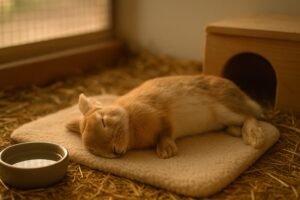Do rabbits sleep in their litter box? It’s a common question among rabbit owners observing their pets’ behavior. Indeed, rabbits do sometimes rest in their litter boxes, and this behavior is generally normal, stemming from their instinct for safety and territorial familiarity. We’ll delve into the habits of these fascinating creatures and what this behavior means for their well-being and care.
Key Takeaways
Rabbits often sleep in their litter box due to their crepuscular nature, finding comfort in the familiar scent and territory they’ve marked, as well as the design that accommodates their burrow-like needs.
A proper litter box setup is key for rabbit comfort, requiring ample space to relax, ventilation for breathability, and the right bedding materials to mimic their natural environment.
While rabbits sleeping in their litter boxes is natural, behavioral changes can signal health issues; it’s essential to monitor for unusual patterns and consult a vet if needed.
Understanding Your Rabbit’s Resting Habits
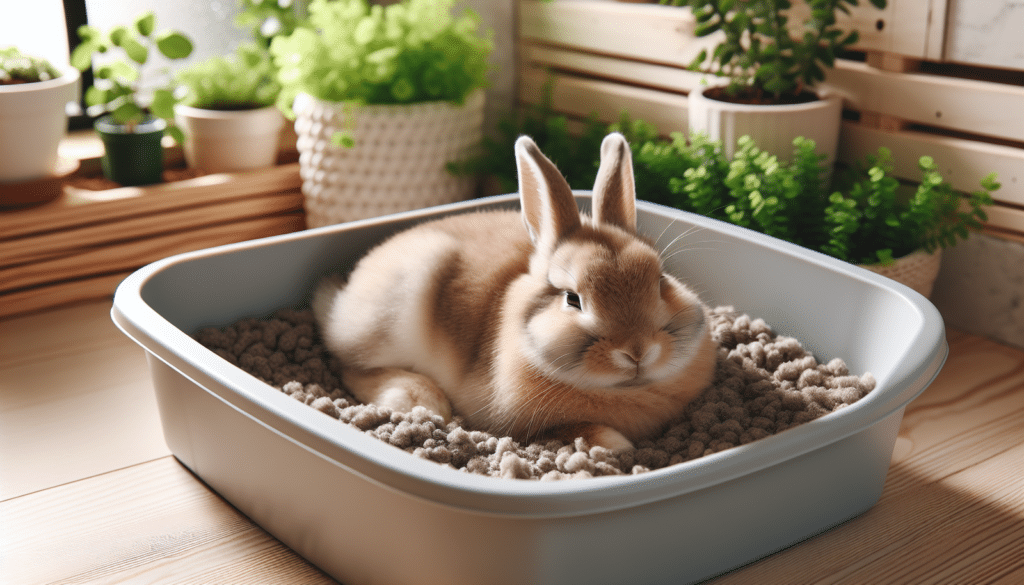
Unlike humans who are diurnal and most active during the day, rabbits are crepuscular. This means they are most active during dawn and dusk, which just happens to be when we often find them lounging in their litter boxes. Far from being lazy, they are merely adhering to their natural sleeping patterns. But why the litter box?
Well, the answer lies in their sense of safety. Just like we humans feel safe in our familiar bedrooms, rabbits feel safe in spaces that smell like them, such as their litter box where they have marked their territory. The comforting smell and the ability to easily become alert from rest make the litter box an appealing place for them to take a nap.
The Allure of the Litter Box
The litter box’s design and structure significantly contribute to its popularity among bunnies. The box mimics a rabbit’s natural environment, leading them to favor it as a sleep area. It’s like their own little burrow inside your house, secure and snug.
The layered plastic grid of the litter box, which might initially strike you as a mere design element, provides air circulation for cooling and a texture that appeals to the rabbit’s senses. It’s these little details that make the plastic tray litter box an attractive sleeping spot for your pet.
Bedding Bliss
A good night’s sleep calls for a comfortable bed, and it’s no different for our furry friends. That’s why rabbit owners find materials like soft hay and paper towels appealing for the litter box. These materials not only provide a cozy surface to curl up on but also have a relaxing fragrance that adds to the comfort factor.
Options for safe rabbit bedding include:
Paper-based pelleted litter
Aspen shavings
Compressed sawdust pelleted litter
Shredded paper
Soft paper-based bedding material
Straw (particularly good for outdoor rabbits as it’s warm, and absorbent and the hollow strands trap air, keeping your rabbit cozy and dry)
Territory and Safety
A litter box is more than just a toilet for your rabbit; it is a place that they have claimed as their own. Rabbits communicate and mark territory by scenting, which involves rubbing their chin on objects or people to claim them as their own. This is why they often choose their litter box as a safe napping spot – it’s familiar, and they’ve marked it as their territory.
As prey animals, rabbits also find it safer to sleep inside where they eat, which often is their litter box. This way, they can minimize movement and reduce exposure to potential predators. It’s all about staying alert and safe, even while they catch some z’s.
The Litter Box Setup: A Bunny’s Bedroom?
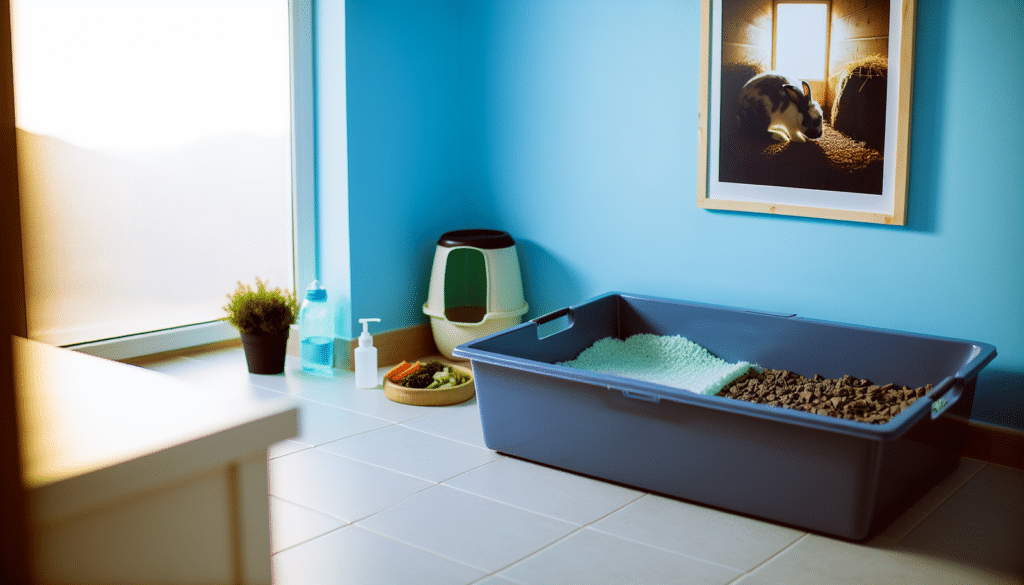
Transforming the litter box into a comfortable sleeping area requires attention to size and ventilation. Rabbits need ample room to stretch out and relax, so the amount of floor space in a litter box can dictate whether a rabbit may choose to sleep there.
Just as important as size is the air circulation in a litter box setup. Proper ventilation is crucial for maintaining a rabbit’s comfort, especially in their sleeping environment. This is where the design of your rabbit’s living space comes into play. A sheltered and comfortable area can greatly influence their sleep and relaxation habits, potentially leading them to adopt the litter box as a resting place.
Size Matters
When choosing a litter box, size isn’t just a matter of convenience for you; it’s a matter of comfort for your bunny. A rabbit needs a litter box that can accommodate both their bathroom and sleep needs. This means the box should be spacious enough for them to comfortably sit at one end, with room for a pile of hay at the other.
For a single small rabbit, a litter box measuring at least 40cm x 25cm is recommended. And if you’re a proud owner of multiple rabbits, ensure the litter box is spacious enough to fit at least two rabbits simultaneously to support their communal habits. A sufficient litter box size promotes comfort during rest and helps maintain cleanliness and order in the rabbit’s living space.
Ventilation and Comfort
Proper ventilation isn’t just for comfort; it’s a matter of health. Enclosed spaces like covered litter boxes can lead to a buildup of humidity and temperature, negatively impacting a rabbit’s comfort unless there’s proper air circulation.
Adequate ventilation in a litter box is crucial to prevent the dangerous buildup of ammonia and to maintain a healthy sleeping environment. That’s why using a litter box with a grid or mesh floor can help keep rabbits clean and dry, enhancing their comfort. Additionally, this can aid in the process of litter training your rabbit, making them litter trained.
If your rabbit likes to relax in their litter tray, consider boxes that aren’t fully enclosed or have additional holes to ensure ample air circulation.
Behavioral Patterns: When Sleeping Meets Eating
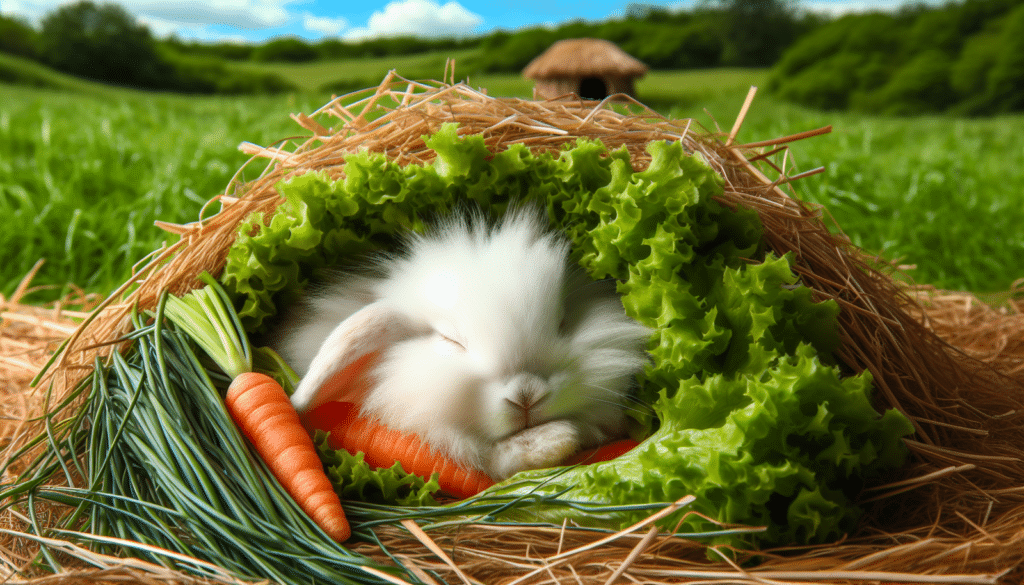
If your rabbit seems to eat and sleep in the same spot, rest assured, this is a common observation. This is a common behavior amongst rabbits, primarily driven by their natural habits and the comfort and convenience of the litter box.
Due to their crepuscular nature, rabbits are most active at dawn and dusk. This leads them to eat and sleep in the same spot during the middle of the day and night. The litter box provides a tactical advantage for sleeping rabbits to remain vigilant with their eyes open, thanks to a transparent membrane called the third eyelid.
Dining and Dozing
Following short periods of activity, many rabbits usually settle down for a rest, often coinciding with their feeding times. This causes them to eat and sleep in the same area, which is where the rabbit sleeps.
Adding fresh hay to the litter box has several benefits for rabbits:
It maintains cleanliness and minimizes odors
It enhances a rabbit’s eating and resting experience
Positioning a hay rack or pile next to the litter tray caters to a rabbit’s habit of chewing while defecating and can aid in transitioning them to a distinct resting spot.
Understanding and accommodating these habits ensures an optimized environment that suits their perfectly normal, natural behavior.
Cleanliness Concerns
Even though rabbits are known to sleep and eat in the same place, they prefer to have separate dedicated areas in their habitat for sleeping, eating, and toileting. This is because rabbits are extremely clean animals by nature.
To maintain hygiene in their living environment, rabbits utilize a specific toilet area, often equipped with newspaper or a litter tray. This helps keep their eating and sleeping spaces clean, contributing to their overall well-being.
The Health Implications of Litter Tray Lounging
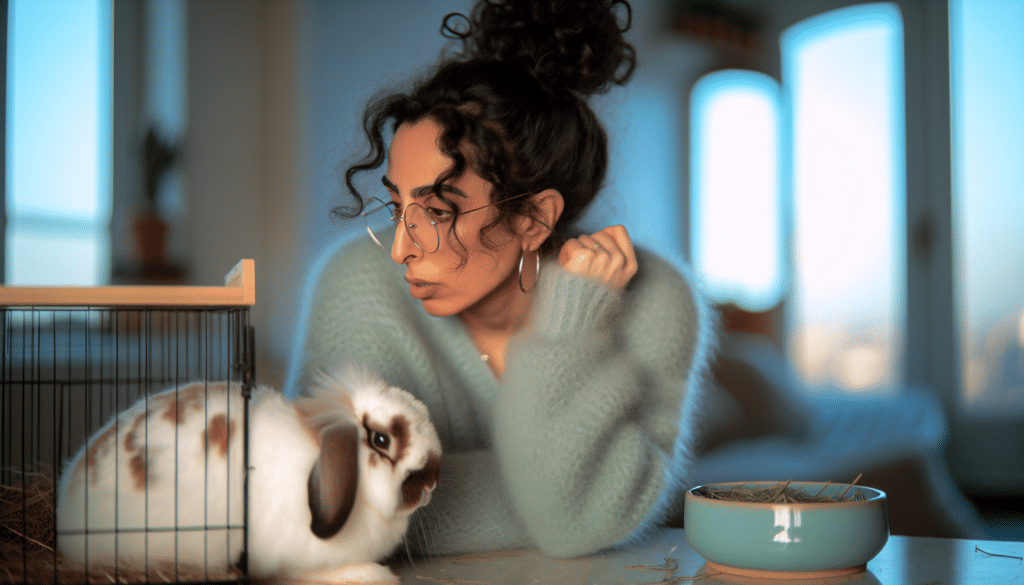
Despite the endearing sight of your bunny snoozing in their litter box, it remains essential to monitor any unusual behavior. If your rabbit is sleeping more than usual in their litter box, it may be a sign of pain or illness and should be examined by a vet.
Certain health issues, like arthritis, can lead to increased time spent in the litter box, as hopping becomes uncomfortable for older rabbits. Urinary tract infections may also cause rabbits to stay close to the litter box due to persistent urges to urinate and abdominal discomfort.
Monitoring for Red Flags
Behavioral changes in your rabbit may signal potential health issues. Look out for the following signs that may indicate changes in your rabbit’s behavior:
Increased time spent sitting in one location, such as the litter box
Changes in eating habits
Changes in defecating habits
Changes in energy levels
These changes may signal illness and should be monitored closely.
If a rabbit fails to consume their caecotrophs, it may point to health issues like obesity or dental problems that prevent them from accessing or eating these droppings comfortably. A sudden habit of sleeping in the litter box, when not previously observed in the rabbit, warrants close observation for potential health concerns.
Alterations in a rabbit’s elimination behavior, such as changes in frequency or location, can also signal issues like illness or fear. If your rabbit suddenly stops following their usual litter box habits, it could be a sign of stress.
When to Consult a Veterinarian
Closely monitoring your bunny’s behavior is critical for their health. Sudden changes in their sleeping patterns, like increased time spent in the litter box, can suggest health concerns.
A male bunny displaying lethargy or hunching over, combined with changes in bathroom behavior, might be experiencing a health issue. Reluctance to move or reduced activity in a rabbit could be symptomatic of GI stasis, a condition necessitating immediate veterinary intervention. If you notice any concerning alterations in toileting or sleeping habits, don’t hesitate to consult a veterinarian.
Creating a Cozy Corner: Alternatives to the Litter Box
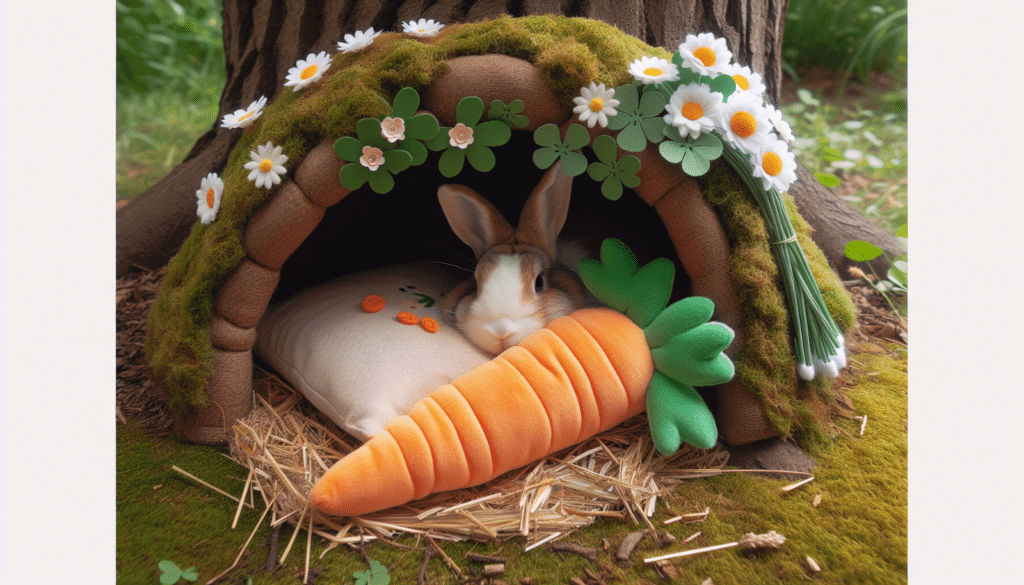
Although rabbits sleeping in their litter box is normal behavior, offering a dedicated rabbit sleep area separate from the litter box may enhance their overall well-being. This could be as simple as providing rabbit-safe bedding, like paper bedding or dust-extracted straw, in a corner of their enclosure for rabbit sleeping.
To further encourage your rabbit to sleep outside the litter box, create a cozy nook that’s warm, dry, and shielded from drafts. Think of it as creating a little bunny bedroom within their habitat.
Designing a Dedicated Sleep Space
As you create a dedicated sleeping area, prioritize your rabbit’s comfort. This space should include places for them to hide, meeting their need as prey animals to feel safe and secure.
Each hiding place should have at least two entrances/exits to prevent feelings of entrapment, offering multiple escape routes. When it comes to bedding, wheat straw can provide better insulation and warmth, making the dedicated sleeping area inviting and comfortable for your rabbit.
Transition Tips
Introducing a new sleeping area can be a big change for your rabbit. To help them adjust, introduce familiar objects like toys and bedding to the new area. This can comfort the rabbit by providing a sense of familiarity through scent.
Maintaining a consistent daily routine helps reduce stress during the transition and makes the environment predictable, which is essential for rabbits’ adjustment. Start your rabbit in a small, quiet space and gradually increase their accessible area, helping them adjust without feeling overwhelmed and building their confidence. Incentivizing exploration with hidden treats near the new sleeping area can reward the rabbit for venturing out from their familiar litter box.
Practical Tips for a Hygienic Habitat
A clean and hygienic habitat is vital for maintaining a rabbit’s health and well-being. Their living areas, including litter boxes, should be well-ventilated, dry, and free from drafts to prevent respiratory illnesses.
Maintaining separate sleeping and toilet areas within a rabbit’s habitat is crucial for cleanliness. Rabbits thrive in clean environments, and the litter box should be cleaned daily with new litter added as necessary, and washed weekly with soap and water to maintain a hygienic habitat.
Regular Cleaning Routines
Maintaining a sanitary environment requires regular cleaning routines. The litter should be refreshed daily, with full contents dumped every few days to once a week depending on the box size and the rabbit’s output.
The hutch, including the drop tray, should be cleaned and disinfected at least once a week. Unsanitary conditions, such as urine-soaked hay, can lead to respiratory issues in rabbits, so regular replacement of litter box hay is crucial for their health.
To reduce rabbit stress during cleaning, a small part of the hutch should be left untouched and the cleaning should take place while the rabbit is out playing.
Choosing the Right Litter
The selection of safe and absorbent litter materials aids in keeping a habitat clean and free from odor. Paper-based, unscented litter is optimal for rabbits as it is highly absorbent and safe for their digestive and respiratory systems.
Wood pellets offer the following benefits as a litter material:
Excellent odor control
Require less frequent changing
More absorbent than newspaper and bulk hay
More economical daily usage
While newspaper and bulk hay are cost-effective litter materials, their lower absorbency necessitates more frequent changes. Pelleted litters are more absorbent than softer options, enabling a more economical daily usage.
Summary
We’ve hopped through the intriguing world of rabbit behavior, decoding why our furry friends prefer to snooze in their litter boxes. From their natural sleeping patterns to their instinctual need for safety and territory, there’s more to this behavior than meets the eye. But remember, with a few simple steps and a keen eye for changes in behavior, we can ensure our bunnies lead happy, healthy lives, whether they’re snoozing in their litter box or a cozy corner we’ve created just for them.
Frequently Asked Questions
Why is my bunny sleeping in the litter box?
It’s normal for rabbits to use their litter box as a sleeping spot. You can make it more comfortable for them by using a soft paper-type litter like Carefresh.
Should I put bedding in my rabbits litter box?
Yes, you should put bedding and hay in your rabbit’s litter box to create a comfortable and appropriate environment for them. This will help keep your rabbit happy and healthy.
What do pet rabbits like to sleep in?
Pet rabbits like to sleep in bedding that is safe, comfortable, and warm, such as shredded paper, aspen shreds, specialist litter or pellets, and hay. These options are safe for them to eat and nest in.
Do rabbits like being pets while sleeping?
Rabbits are less responsive to petting while completely asleep. The best time to pet them is when they are relaxed and chilled out, but not asleep, such as when they are loafing around or sprawled out on the ground.
What factors make the litter box an appealing sleep area for rabbits?
Rabbits are attracted to litter boxes as sleep areas due to comfortable bedding and sufficient space, making it cozy for them. Consider these factors when setting up a sleeping space for your rabbit.

